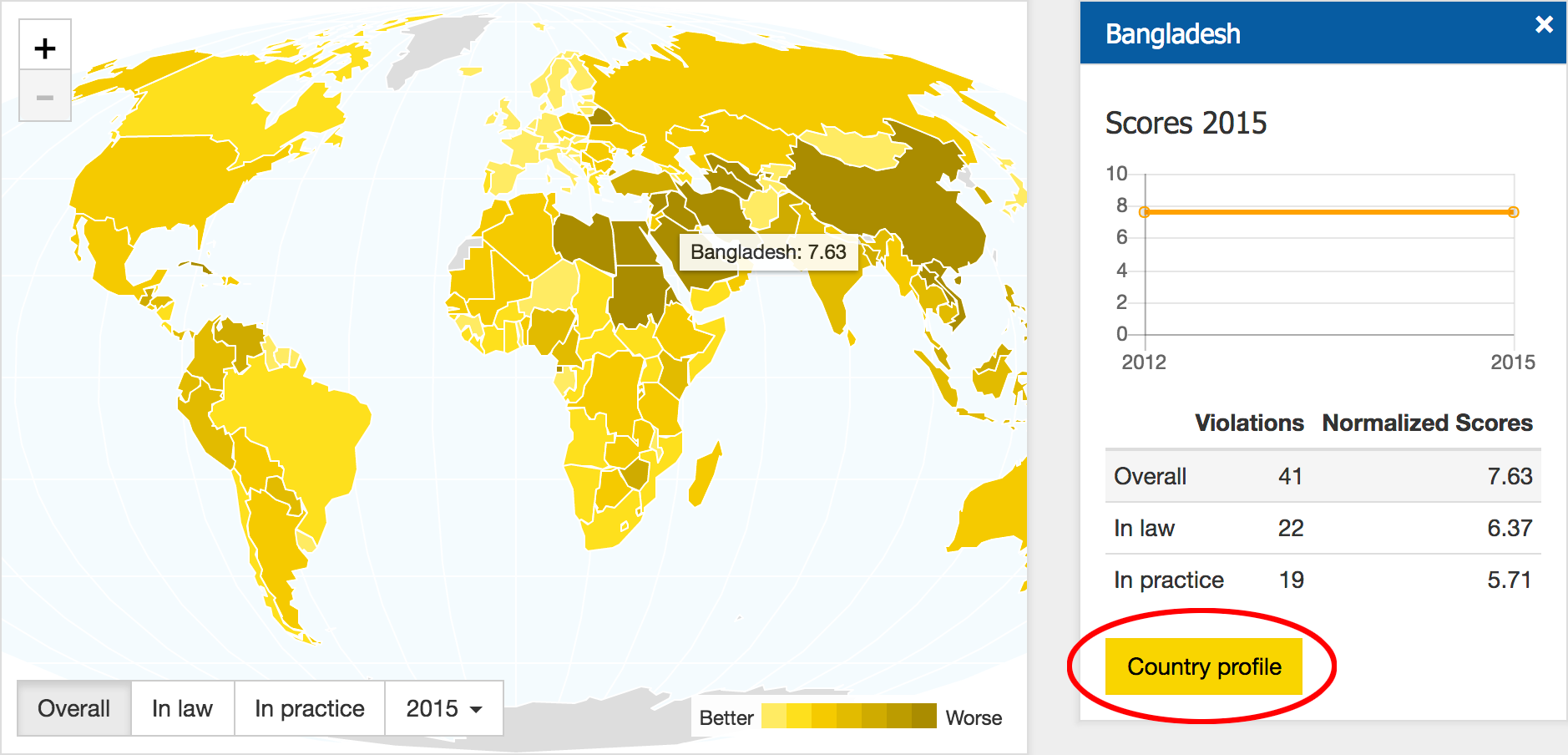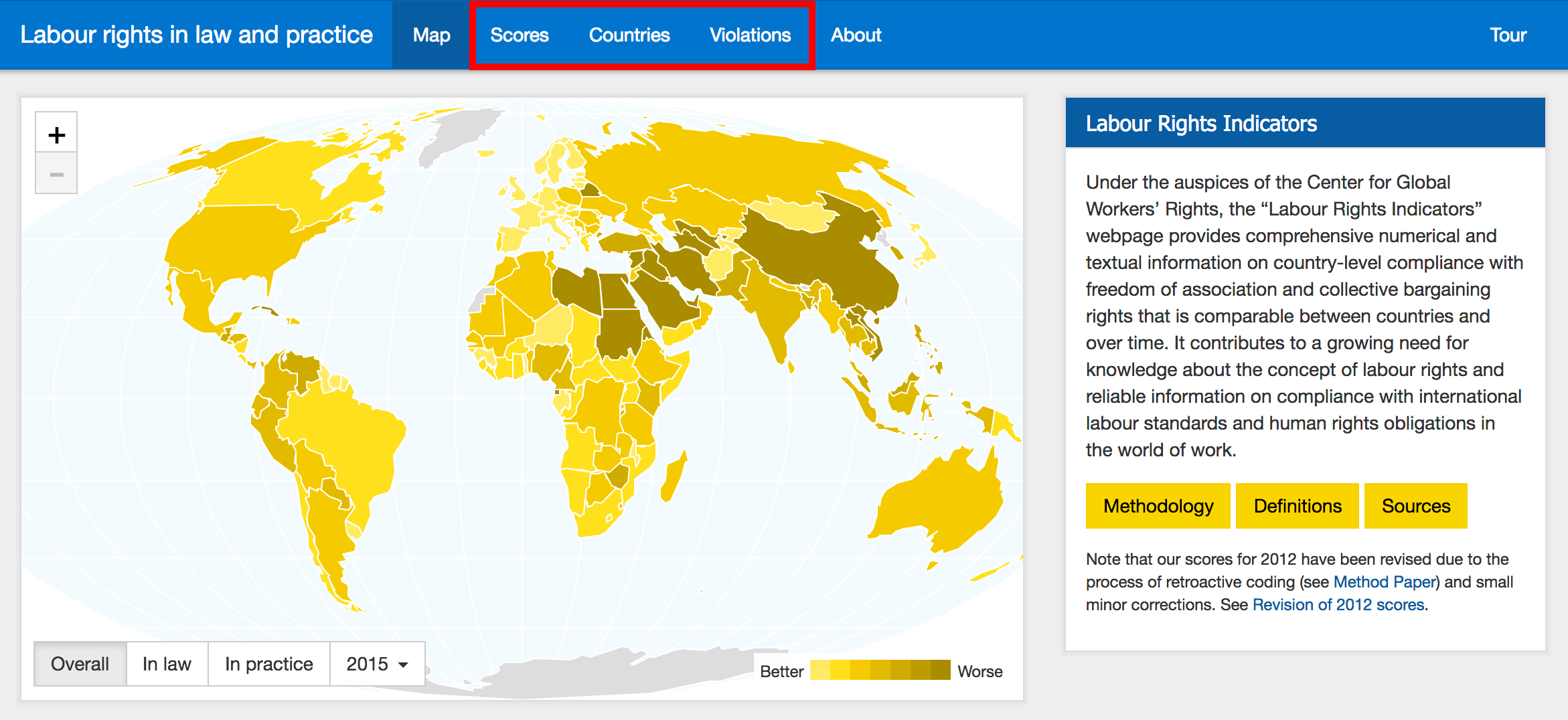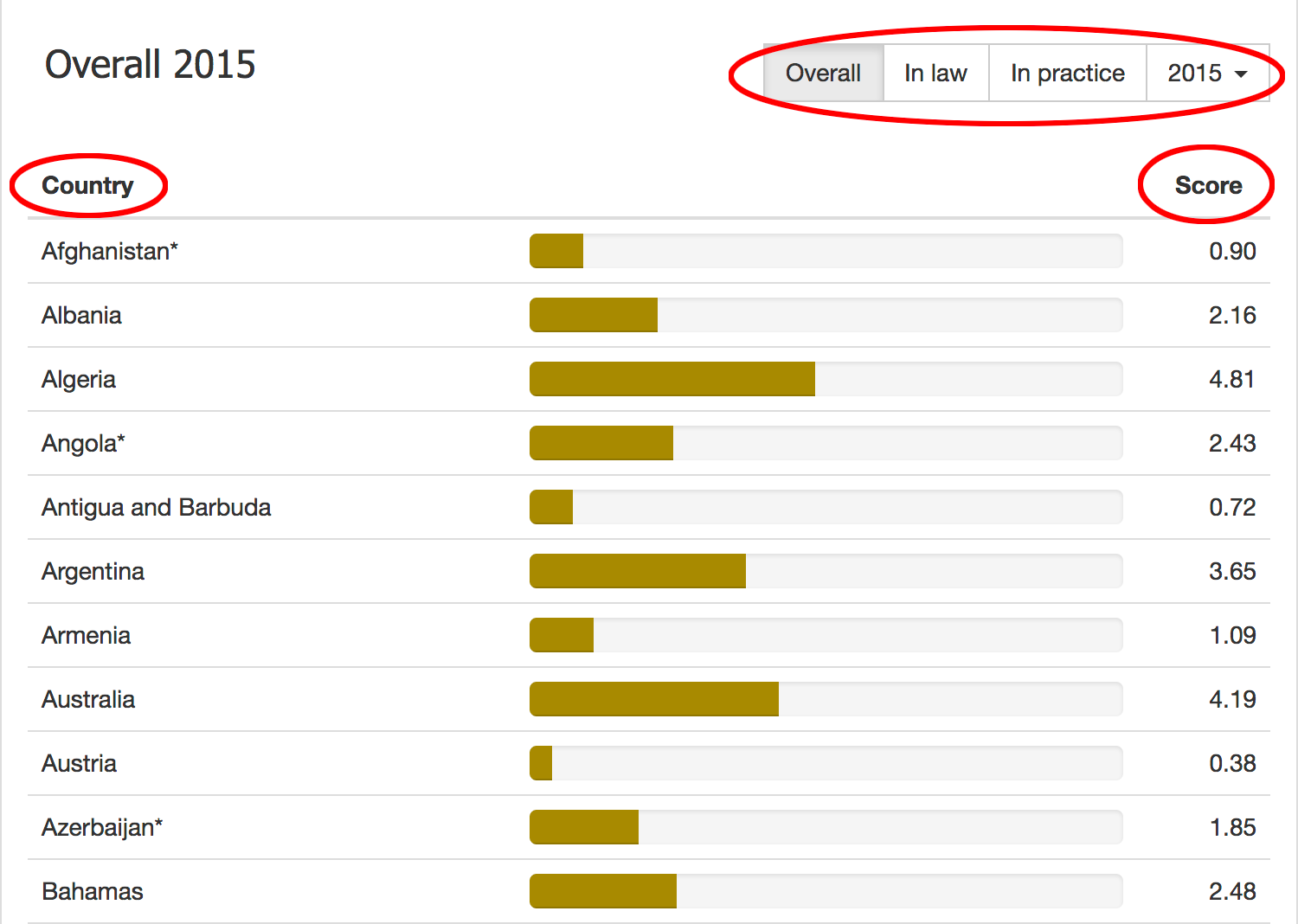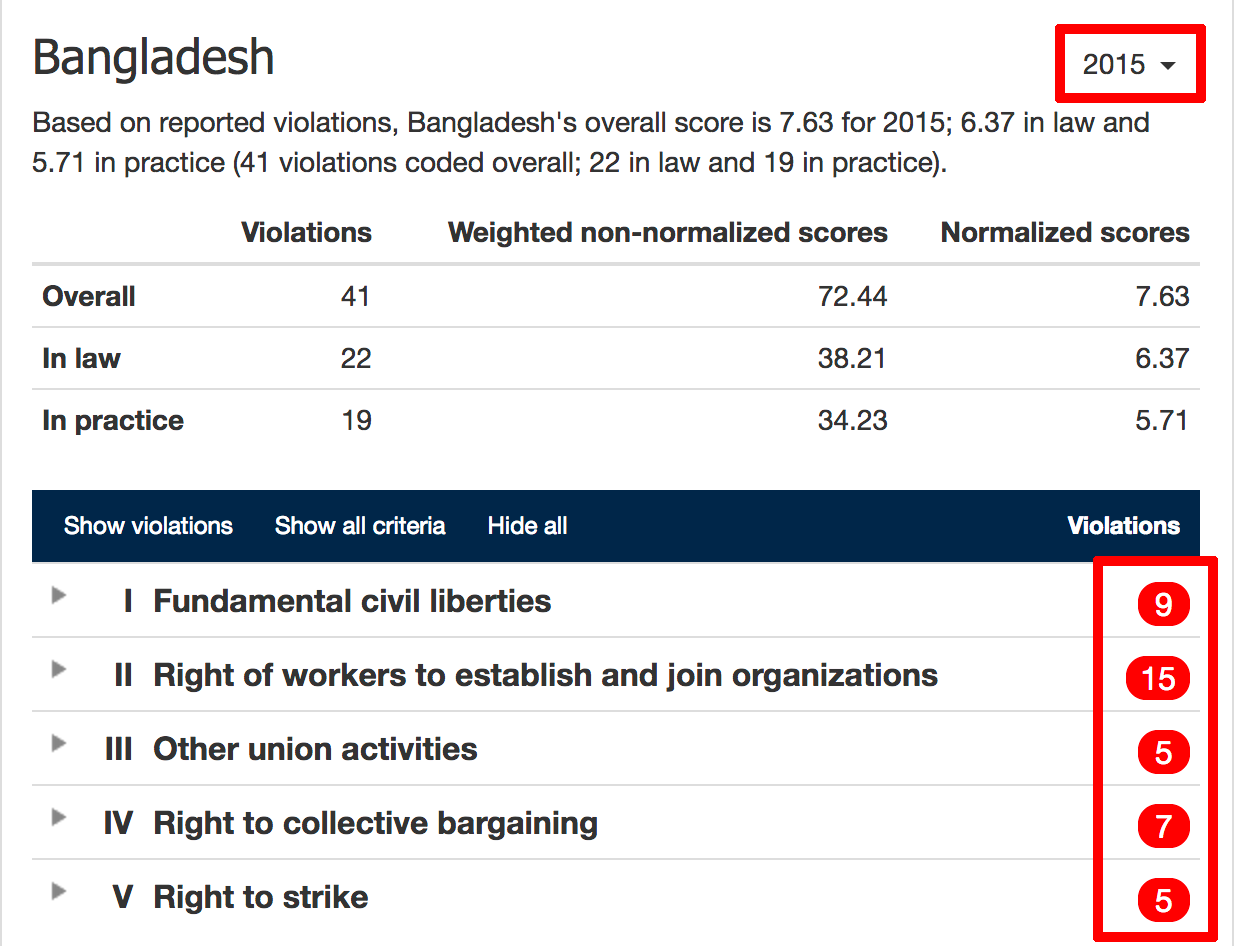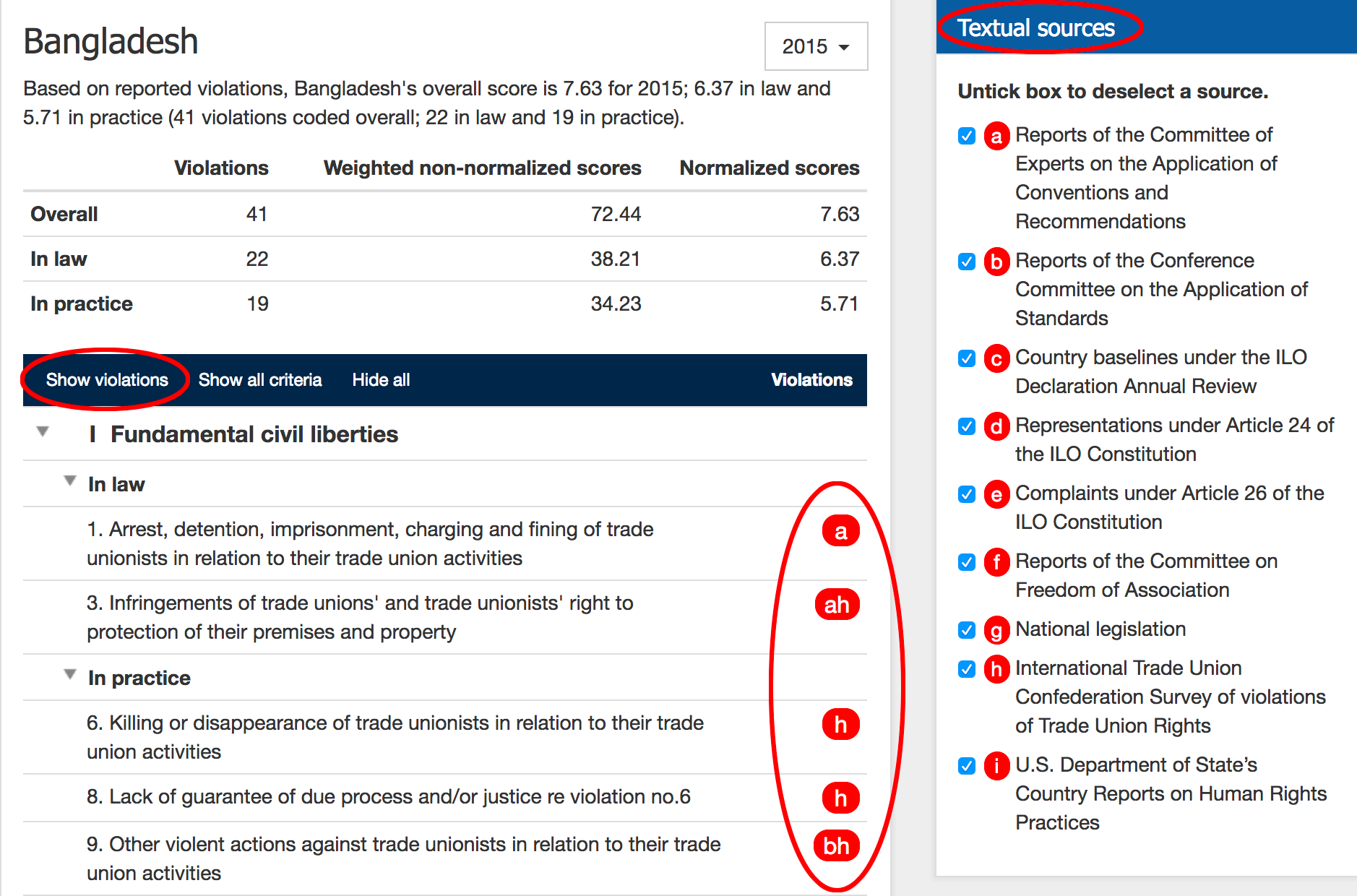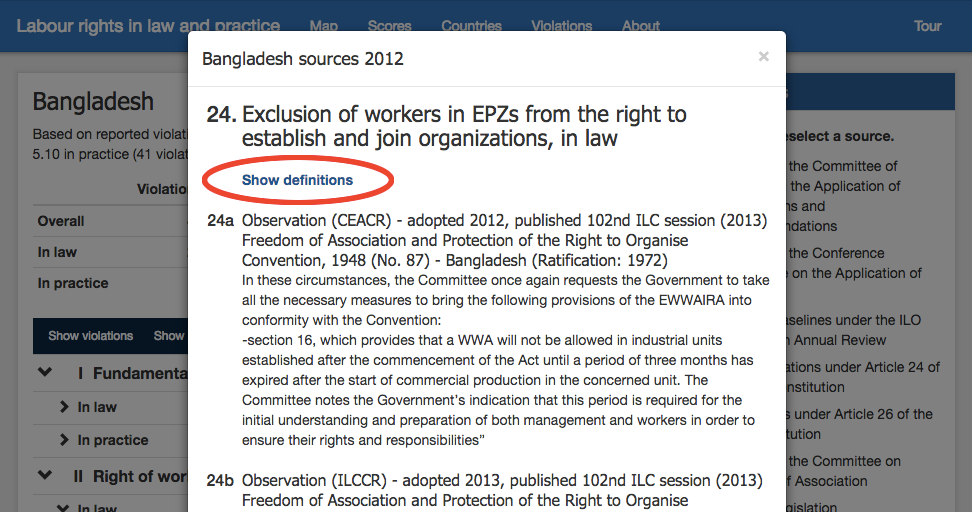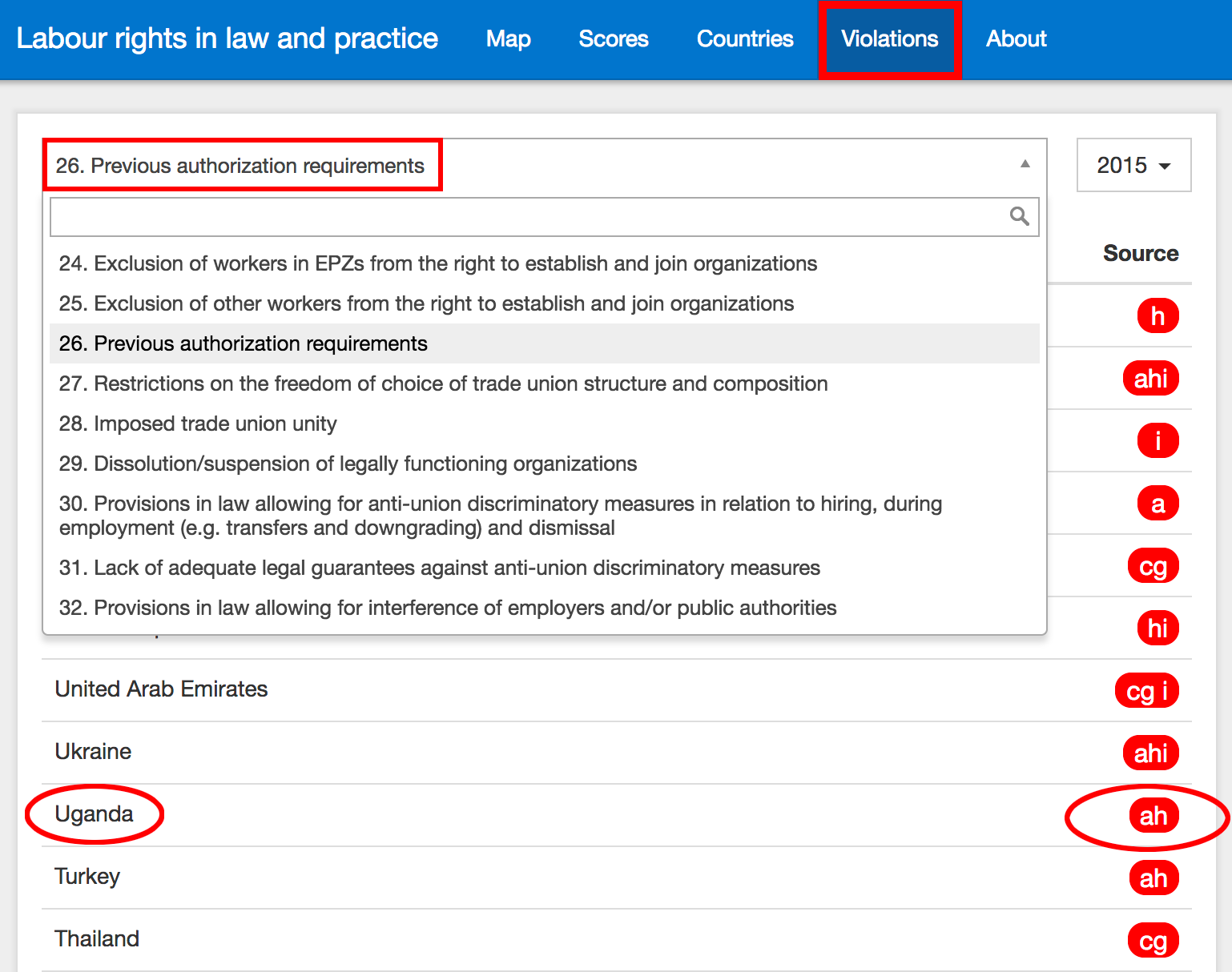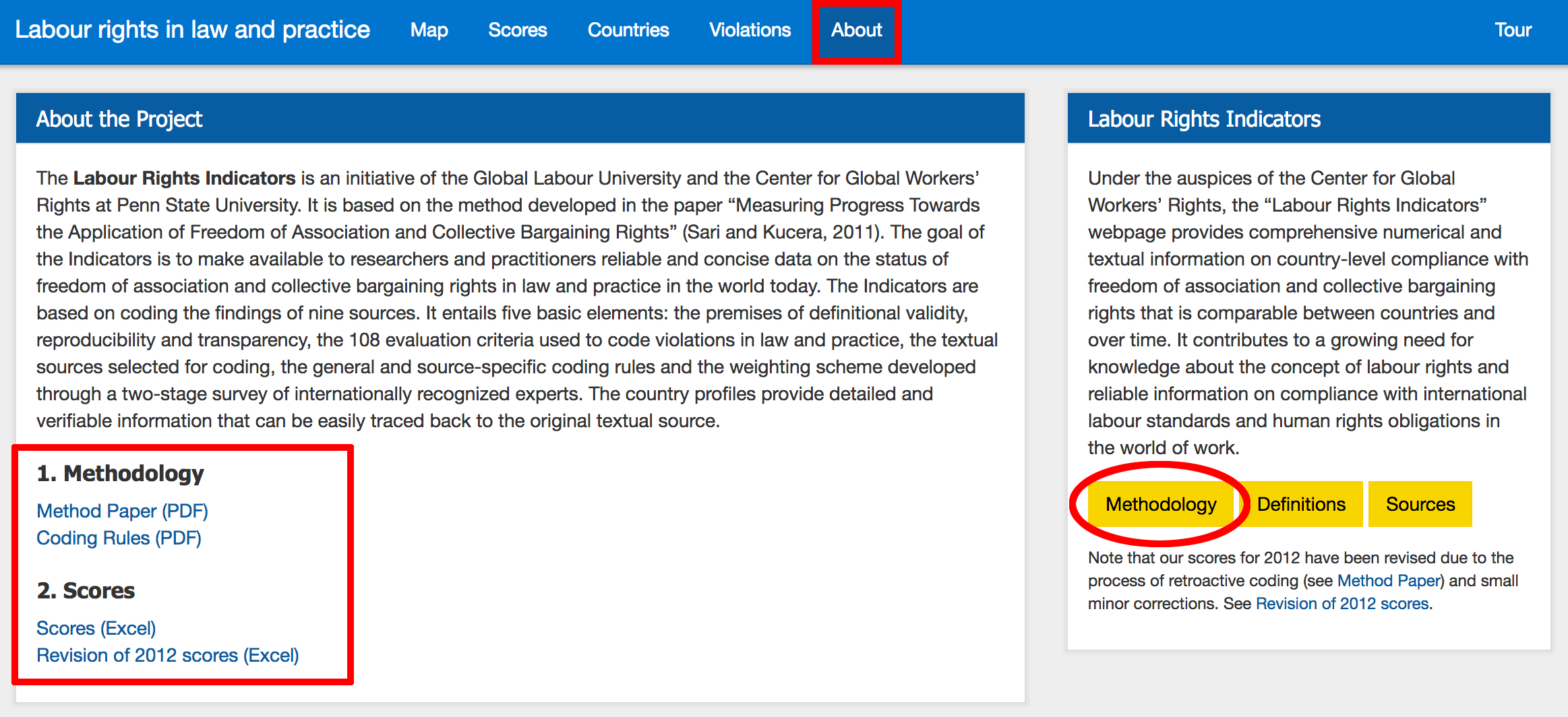| Country | Score |
|---|
* We do not recommend the use of scores for the asterisked countries for reasons noted on pp. 11-12 of the Method Paper (PDF). Nonetheless, we do provide the underlying texts for the coded violations on the country page and consider this to be useful for users.
| Violations |
|---|
About the Project
The Labour Rights Indicators is an initiative of the Global Labour University and the Center for Global Workers’ Rights at Penn State University. It is based on the method developed in the paper “Measuring Progress Towards the Application of Freedom of Association and Collective Bargaining Rights” (Sari and Kucera, 2011). The goal of the Indicators is to make available to researchers and practitioners reliable and concise data on the status of freedom of association and collective bargaining rights in law and practice in the world today. The Indicators are based on coding the findings of nine sources. It entails five basic elements: the premises of definitional validity, reproducibility and transparency, the 108 evaluation criteria used to code violations in law and practice, the textual sources selected for coding, the general and source-specific coding rules and the weighting scheme developed through a two-stage survey of internationally recognized experts. The country profiles provide detailed and verifiable information that can be easily traced back to the original textual source.
Following a Resolution by the International Conference of Labour Statisticians in October 2018, the method provides the basis for Sustainable Development Goal indicator 8.8.2 on labour rights.
The Center for Global Workers’ Rights (CGWR) was recognized on December 1, 2012 as a research center within the School of Labor and Employment Relations by the College of the Liberal Arts of The Pennsylvania State University. Its goals include supporting student and scholar research on workers’ right with a particular focus on vulnerable workers in the most precarious sectors of the economy. It also seeks to disseminate those research findings through its working paper series, research reports, scholarly publications, and scholar-practitioner exchanges through an annual international symposium. Center goals also include training the next generation of scholars and practitioners. To contribute to this goal, in August 2014, the Center launched a Masters in Professional Studies (MPS) in Labor and Global Workers’ Rights, a one-year Masters program focusing on global workers’ rights that is part of the Global Labour University network. Read more
The Global Labour University (GLU) is a network of trade unions, universities and the International Labour Organization (ILO) to deliver high-level qualification programs. It offers Masters Courses in five different countries on trade unions, sustainable development, social justice, international labor standards, multinational companies, economic policies and global institutions and promotes research cooperation on global labor issues. The Global Labour University is a new approach to increase the intellectual and strategic capacity of workers organizations and to establish stronger working relationships between trade unions, the ILO, and the scientific community. Read more
1. Methodology
Method Paper (PDF)
Coding Rules (PDF)
2. Scores
The file "All scores 2012-2020 July 2023" contains revised scores (based on retroactive coding) for the years 2012, 2015, 2016 and 2017 as well as the first release of scores for the years 2018, 2019 and 2020.
The file "All scores 2000-2017 Dec 2019" contains scores for the years 2000, 2005, 2009, 2012, 2015, 2016 and 2017. The scores in this file do not include the latest revisions (based on retroactive coding) but only revisions undertaken by December 2019.
For more on retroactive coding, please see the method paper on the website.
Note that the scores for the years 2012, 2015, 2016 and 2017 differ somewhat between the two files and that there is a break in the series between the years 2009 and 2012. Thus, users wanting to evaluate a strictly comparable time series going back to 2000 should use the file "All scores 2000-2017 Dec 2019"; users wanting to evaluate a strictly comparable time series from 2012 should use the file "All scores 2012-2020 July 2023".
Please note that we are aiming to revise the coding for the years 2000, 2005 and 2009 as soon as possible, in order to having a strictly comparable time series from 2000 to the most recent year available.
All scores 2012-2020 July 2023 (Excel)
All scores 2000-2017 Dec 2019 (Excel)
Revision of scores Dec 2019 (Excel)
The coding of ILO textual sources and national legislation is downloaded from the website for UN SDG indicator 8.8.2, for which the ILO is the custodian and for which the method for the Labour Rights Indicators provided the foundation (see p. 2, footnote no. 2 of the Resolution concerning the methodology of the SDG indicator 8.8.2 on labour rights, including the 2022 Amendment on the refinements to the methodology). The coding of International Trade Union Confederation Survey of Violations of Trade Union Rights and the U.S. Department of State's Country Reports on Human Rights Practices is carried out by labour law experts in coordination with the Center for Global Workers’ Rights.
Please reference the Labour Rights Indicators database as follows:
Center for Global Workers’ Rights. (Year of download XX). Labour Rights Indicators. Retrieved from http://labour-rights-indicators.la.psu.edu/. (Date accessed: XXX.)
Please reference the method for the Labour Rights Indicators as follows:
David Kucera and Dora Sari. 2019. New labour rights indicators: Method and trends for 2000–15. International Labour Review, 2019, vol. 158, issue 3, 419-446.
Team
Mark Anner is an Associate Professor of Labor and Employment Relations, and Political Science, and he is the Director of the Center for Global Workers’ Rights. He is also the chair of the MPS Program in Labor and Global Workers’ Rights, which is a part of the Global Labour University network. He holds a Ph.D. in Government from Cornell University and a Master's Degree in Latin American Studies from Stanford University. Dr. Anner’s research examines freedom of association and corporate social responsibility, labor law reform and enforcement, and workers’ rights in apparel global value chains in Central America and Vietnam. His publications include Solidarity Transformed: Labor Responses to Globalization and Crisis in Latin America (Cornell University Press, 2011), and “Corporate Social Responsibility and Freedom of Association Rights: The Precarious Quest for Legitimacy and Control in Global Supply Chains” (Politics & Society, December 2012), which in 2013 received the James G. Scoville International and Comparative Best Paper Award from the Labor and Employment Relations Association (LERA). Dr. Anner also was awarded the Penn State 2010 George W. Atherton Award for Excellence in Teaching, the LERA 2011 John T. Dunlop Outstanding Scholar Award, and the ILERA 2012 Luis Aparicio Emerging Scholar Prize. Before beginning his academic career, Mark Anner spent eleven years working with labor unions and labor research centers in Central America and Brazil, and he was a union organizer in Boston.
David Kucera is Senior Economist at the International Labour Organization (ILO). Upon joining the ILO, he began research on the economics of international labour standards, particularly on trade union rights. He previously developed country-level indicators of trade union rights and applied them in econometric models of international trade and foreign direct investment. These indicators are described in a chapter in the volume he edited titled Qualitative Indicators of Labour Standards: Comparative Methods and Applications (Springer, 2007). Together with Dora Sari, he co-authored the paper “Measuring Progress Towards the Application of Freedom of Association and Collective Bargaining Rights” (ILO, 2011), on which the Center for Global Workers’ Rights indicators are based. His other areas of research include gender aspects of development, informal employment and structural transformation. In addition to publishing a number of journal articles, he co-edited and contributed chapters to the volumes In Defense of Labour Market Institutions: Cultivating Justice in the Developing World (Palgrave Macmillan, 2008) and Beyond Macroeconomic Stability: Structural Transformation and Inclusive Development (Palgrave Macmillan, 2013). He received his Ph.D. in Economics from the New School for School for Social Research and was the Assistant Director of the Center for Economic Policy Analysis in New York City prior to joining the ILO. He is an Associate Editor of the journal Feminist Economics.
Dora Sari has over seven years of work experience on the field of international labour regulations, with a specific focus on collective labour rights and relations. Prior to her engagement with the Pennsylvania State University she has worked with, among others, the European Commission and the International Labour Organization and is currently pursuing her PhD degree in political science at the University of Geneva where she is also involved in a two-year project focusing on labour provisions in preferential trade agreements. She has an accomplished academic background in international and national labour law that she has earned through her specialized university course work and Master of Law (LLM) studies in International and European Labour Law and her PhD studies in the area of collective labour rights in the context of economic integration and globalization. She co-authored the paper “Measuring Progress Towards the Application of Freedom of Association and Collective Bargaining Rights” (Sari and Kucera, 2011), on which the Trade Union Rights Indicators are based.
The coding for 2015 was done with the contribution of the following team of lawyers:
- Loredana Carta
- Valérie Prévost Tanguay
The coding for 2016 was done with the contribution of the following team of lawyers:
- Loredana Carta
- Emeline Dupuis
- Ambra Migliore
- Clàudia Nadal Sabaté
The coding for 2017 was done with the contribution of the following team of lawyers:
- Loredana Carta
- Aikaterini Charara
- Clàudia Nadal Sabaté
- Luz Rey Novás
The coding for 2018-2020 was done with the contribution of the following team of lawyers:
- Aikaterini Charara
- Diletta Gambaccini
- Clàudia Nadal Sabaté
Method
1. Countries covered
Countries that are member States of the International Labour Organization.
2. Key premises
Definitional validity:
The premise that the 108 evaluation criteria and their corresponding definitions are directly based on ILO Constitution, ILO Freedom of Association and Protection of the Right to Organise Convention, 1948 (No. 87), ILO Right to Organise and Collective Bargaining and Convention, 1949 (No. 98) and related ILO jurisprudence.
Transparency:
In view of the premise of transparency, the indicators are based on a large number of evaluation criteria ensuring the identification of violations in a precise manner and providing the coding in a way that all coded information can easily be traced back to a particular textual source.
Inter-coder reliability:
The premise that two evaluators working independently arrive consistently at the same result when using the method.
3. Textual sources
- Reports of the Committee of Experts on the Application of Conventions and Recommendations
- Reports of the Conference Committee on the Application of Standards
- Country baselines under the ILO Declaration Annual Review
- Representations under Article 24 of the ILO Constitution
- Complaints under Article 26 of the ILO Constitution
- Reports of the Committee on Freedom of Association
- National legislation
- International Trade Union Confederation Survey of violations of Trade Union Rights
- U.S. Department of State’s Country Reports on Human Rights Practices
4. Violations
5. Definitions
The definitions provided for each 108 evaluation criteria are constructed by listing examples, in many cases taken word-for-word from relevant ILO sources, that depict the type of violations that should be coded under a given evaluation criteria. The illustrative nature of the definitions should be kept in mind, from which the coding of observed violation may be determined in a manner consistent with the classification of ILO Conventions No. 87 and 98 and related jurisprudence.
6. Coding rules
In view of the premise of reproducibility and inter-coder reliability detailed rules were developed to guide the coding. These rules are a) the general coding rules applicable to all sources and b) the source-specific coding rules guiding the specific coding of each of the sources. The general coding rules deal with issues such as the frequency of the coding, codable and non-codable evidence, the automatically triggered coding and default scores etc.
7. Indicators
Violations
Violations are the "raw" unweighted scores indicating the number of reported violations coded for a given year. The raw coding uses the letters “a” through “i” (with each letter corresponding to one of the nine textual sources) to represent coded violations for each evaluation criteria, yielding a column of 108 cells for any given country and year. Any cell containing one or more letters is assigned a value of 1 and any blank cell for which there are no coded violations is assigned a value of 0.
Weights and weighted scores
The weights were constructed with the use of the so-called Delphi method, a two-round survey of internationally recognized experts in labour law having knowledge of the International Labour Organization and its supervisory system and particular knowledge of freedom of association and collective bargaining rights as defined by the ILO. Final ratings used to construct the weights were the average second round ratings among the experts for each evaluation criteria. The ratings were then converted into weights letting minimum and maximum weighting values range from 1 to 2.
Weighted scores are the value of 1 and 0 assigned to the row scores multiplied by the corresponding weight of the violation.
Normalised scores
The non-normalized score for any given country and year is normalized to a range in value from 0 to 10, the best and worst possible score respectively. To overcome the issue of changing maximum observed values when normalizing over time, a maximum weighted non-normalized score of 95 was assigned when normalizing overall scores. For in law and in practice scores a maximum weighted non-normalized score of 60 was assigned. Should any country in the future receive a non-normalized score greater than 95 for overall, or 60 for in law or in practice score, this will be capped at 95 or 60 respectively, yielding a normalized score of 0.
Indicator "Overall"
Normalised score of the sum of weighted violations in law and in practice.
Indicator "In Law"
Normalised score of weighted violations in law, i.e. national legislation that is not in conformity with freedom of association and collective bargaining rights as defined by the ILO as well as to actions taken on the basis of such legislation.
Indicator "In practice"
Normalised score of weighted violations in practice, that is acts committed in violation of the existing national legislation that is in conformity with freedom of association and collective bargaining rights as defined by the ILO.
Default scores
Worst possible score of 10 assigned by default to a country for all-encompassing violations of freedom of association and collective bargaining rights, that is, for “General prohibition of the right to establish and join organizations” in law (violation no. 23) “General prohibition of the development of independent workers' organizations” in practice (violation no. 36). This rule applies both for the overall indicator as well as the indicators in law and in practice.
Supporters
The Labour Rights Indicators project is grateful for the generous funding of the following supporters:
Contact
Center for Global Workers’ Rights
501 Keller Building
University Park, PA 16802
cgwr@psu.edu
Labour Rights Indicators
Under the auspices of the Center for Global Workers’ Rights, the “Labour Rights Indicators” webpage provides comprehensive numerical and textual information on country-level compliance with freedom of association and collective bargaining rights that is comparable between countries and over time. It contributes to a growing need for knowledge about the concept of labour rights and reliable information on compliance with international labour standards and human rights obligations in the world of work.
Methodology DefinitionsNote that our scores have been revised due to the process of retroactive coding (see Method Paper) and small minor corrections.
Textual sources
Untick box to deselect a source.
About
The Labour Rights Indicators are based on coding the findings of selected nine sources and compiling this information in a readily accessible and concise manner. It is designed to be used both by practitioners and researchers. It builds on five basic elements: the premises of definitional validity, reproducibility and transparency; the 108 violation type used to code violations in law and practice; the textual sources selected for coding; the general and source-specific coding rules; and the rules to convert the coded information into normalized indicators. The country profiles provide detailed and verifiable information over time that can be easily traced back to the original textual source.
Please reference the Labour Rights Indicators database as follows:
Center for Global Workers’ Rights. (Year of download XX). Labour Rights Indicators. Retrieved from http://labour-rights-indicators.la.psu.edu/. (Date accessed: XXX.)
Please reference the method for the Labour Rights Indicators as follows:
David Kucera and Dora Sari. 2019. New labour rights indicators: Method and trends for 2000–15. International Labour Review, 2019, vol. 158, issue 3, 419-446.


